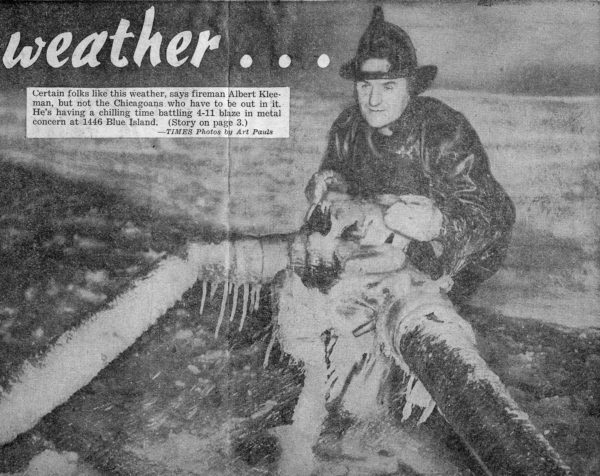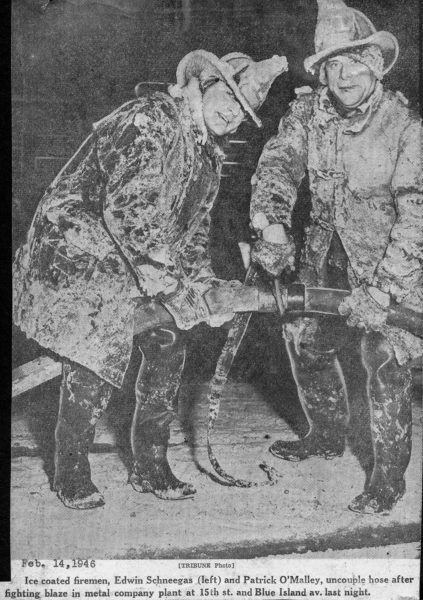This from Steve Redick:
Going through my dad’s scrapbook I found these images from Feb 14, 1946. 4-11 alarm at 1446 Blue island Ave. In the writeup it says the captain of Squad 10 died of a heart attack at another fire that occurred that same day … barely mentioned.The next group of clippings describes a squad’s multiple inhalator responses and a dramatic elevator rescue..imagine how difficult and dangerous this was without all the modern tools of today.
Also some clippings from a 5-11 at 19th and State. Interesting how they refer to the residents displaced in the hotel fire, imagine that term used today! How about the mention of the “47 year old midget” hit by the streetcar during the fire. You can’t make this stuff up! These clippings are a window to a different time in this country, and a whole different kind of journalism.
Steve



































#1 by Bill Post on August 18, 2016 - 8:07 PM
Thanks for the remarks Mike. I remember the squad caps very well, in fact I also have memories of the old squads responding to inhalator runs. If you recall the old inhalator/pulmotors were much larger and they were contained in large trunk style boxes which were the size and style of a suitcase with handles on the ends. It was a common sight to have two of the squad crew carry the inhalator box into the building by the handles and several of the squad crew would follow them usually carrying extra oxygen bottles.
Those other cities that you are talking about are New York which always dispatched fire alarms by the box number (even if the fire was reported from a telephone). As a rule they would dispatch a full box alarm assignment which usually was 3 engines and 2 trucks and a battalion chief.
If it was a working fire (which they refer to as an “all hands working” or a signal 75 or a 10/75) they would then get a 2nd battalion chief, a rescue company, and they could also get a division chief if it was serious. Due to a skyrocketing fire alarm rate during the 1960s, New York City stopped sending the third engine unless multiple calls were received on the box.
In Philadelphia, their fire department did have a less then full box alarm response called a local alarm and would normally get an engine, truck and a battalion chief.
In New York City their Box Alarms were transmitted through a primary and a secondary bell system.
I’m not sure how it was done in Boston and Baltimore.
#2 by Drew Smith on August 18, 2016 - 6:34 PM
The terms still alarm and box alarm come from the days of the telegraph fire alarm when it was the only means of communicating an alarm as telephones had not been widely popularized. A still alarm referred to a request for the fire department that was reported generally in person to a firefighter at the fire station. A box alarm referred to an alarm that was reported using a street corner telegraph fire alarm box. The assignment for the box alarm with stored at each station on index cards. Most companies had there still district and their first alarm responses memorized. As with anything as time went on the use of these two terms was expanded upon and the response assignment of companies improved.
#3 by outsider on August 18, 2016 - 4:07 PM
It was once explained to me that way back in the day the engine/truck/squad response was the only thing moving on any given event and that everyone else listening to the ticker traffic was to stay “still”.
Hence the origin of the term “still alarm”.
The next alarm on the event dispatched units from the nearest house at each compass point, forming a four sided “box” around the event.
Hence the origin of the term “box” alarm.
I don’t know how reliable this tidbit is, I’m just throwing it out there.
#4 by Mike Mc on August 18, 2016 - 8:41 AM
Excellent report Bill. They would wear their “squad hats” on the inhalator calls so as not to alarm other residents or hospital staff who might believe there was a fire. They became 7 man companies in the late 1950’s although they rarely ran with 7. Someone would almost always be detailed out to another company. If the engine they shared quarters with only had 4 that day, they would usually put the sixth man on the engine and run five and five. The old squads were why the city only responded with one truck on a still alarm back then which in hindsight, was probably a big mistake. The city also ran with only one engine on a still until about 1960. I digress but Chicago was more dependent on their fire alarm office than probably any other city. Most cities would send three engines and two trucks on a first alarm and usually would refer to it as a “box” and Chicago would only send one engine, one truck, and -if available – a squad on a “still”. It was very important for the “office” to box it if they though it was a good fire. It was very rare in most other cities for the fire alarm office to pull a second alarm on their own initiative although it did happen but usually for a major emergency such as a plane crash, train crash, or explosion. In Chicago, it was not only standard operating procedure, it was essential.
#5 by Bill Post on August 17, 2016 - 11:05 AM
Thanks for showing us those interesting clips Steve. On the subject of Chicago’s
Squad companies and “Inhalator duty”, the Squad companies were responding to “Inhalator” and other Special Duty calls since around 1916 which is around the time when Squads 4 through 10 were put in service. That was in addition to responding to still alarms of fire. The Chicago fire department ambulance service didn’t begin serving the public until during 1946 and even then the CFD ambulances were only first due on accidents. The (6 man) Squad companies continued responding first due on inhalator which also known as “pulmotor” runs until April of 1955 when the ambulances were given that responsibility as well. Even so the “old” Squad companies still were dispatched on many inhalator runs when the nearest ambulance wasn’t available (which was quite often) until 1967/68 when the remaining Squad companies were taken out of service. The new Salvage Squads which had replaced a few of the Squad companies also were dispatched on some inhalator runs for the few years that they were in service, however, they were all out of service by the end of 1972. The “Old Squad” companies responded automatically to still alarms in their still districts along with the first due Engine and Truck which is why they were the “work horses” of the Chicago Fire Department as they were responding to both fire and Ems type runs constantly. From 1946 to 1949 Squads 11,12 and 13 were put in service however the Squads still had large very large districts.Before they were given radios around the late 40’s and early 50’s they would have to complete their runs and then call the alarm office from a fire box or a telephone.
#6 by Marty Coyne on August 17, 2016 - 8:43 AM
Great snapshot of fire and cultural history. Thanks for posting.